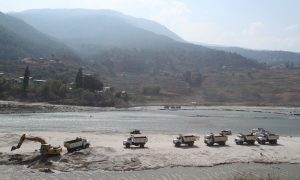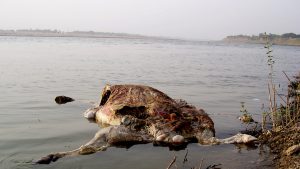As Nobo Borsho (New Year’s Day) was celebrated in West Bengal, the traditional lunch should have started with Ilish Bhaja, Hilsa fried in mustard oil. In Kolkata homes today, that is legend.
Just as Hilsa has become history, well almost, in Baksi village, once known as Hilsa village. Just 55 km from Kolkata, Baksi on the banks of the Rupnarayan river got its nickname because just a majority of residents either caught that king of fish or sold it. But now Hilsa (Tenualosa ilisha) has all but vanished from the Rupnarayan, the tributary that joins the Ganga just before it reaches the Bay of Bengal.
“Previously out of nearly 650 families in Baksi, over 400 were exclusively involved in catching Hilsa,” Bimal Mandal, secretary of Rupnarayan river motsojibi union; a platform of local fishermen, told thethirdpole.net. “However with the catch dwindling, now most have ventured into catching other fishes and a few have even changed profession. The story is almost same in all the villages in Howrah district as Hilsa is hardly found in Rupnarayan river now.”
Fishing boats lie upturned on the banks. The non-appearance of the silver-sheened Hilsa in Baksi is now a rule rather than the exception in West Bengal. According to the Central Inland Fisheries Research Institute (CIFRI) and the state government’s fisheries department, the Hilsa catch has come down from 77,912 tonnes in 2000-01 to 9,887 tonnes in 2014-15; a decline of close to 90%.
“The decline has been quite consistent, apart from 2010-11, when there was a bumper crop,” Utpal Bhaumik, former head of riverine ecology and fisheries division of CIFRI, tells thethirdpole.net.
No entry
The data shows the catch decline is more pronounced upriver than in marine waters. From 2000 to 2015, the catch off the West Bengal coast has gone down 80% (44,810 to 8,900 tonnes) while the inland catch dwindled nearly 97% (33,102 to 987 tonnes).
Slowly the Hilsa has retreated back to the Bay of Bengal
“The inland Hilsa catch data clearly reflects how its upriver migration has been affected over the years,” says Bhaumik. “There are a number of reasons for the trend, the most important being the sedimentation and lack of adequate depth in the Ganga, including at the estuary.”
The Hilsa wants a water depth of around 40 feet in the river mouth before it will enter from the sea. For years now, the depth at the mouth of the Ganga has been no more than 30 feet, often less during the lean non-monsoon months. High sedimentation at various points upriver adds to the problem.
The Hilsa actually assemble near the mouth of the Ganga but then most find the water too shallow and move towards Bangladesh and Myanmar, explains Bhaumik. And this is despite the fact that upriver migration — for spawning — happens during the monsoon.
Apart from lack of water, the reason for the vanishing catch is overfishing, of course.
The ban
The West Bengal government has now banned Hilsa fishing during the peak breeding season — around the full moon in October.
Three stretches on the Ganga have been declared Hilsa sanctuaries — Godakhali near Diamond Harbour; Hooghly Ghat near Triveni; and Lalbag-Farakka.
This follows the Hilsa management model that has been such a success in Bangladesh, but in West Bengal the restriction has remained mostly on paper.
Fish for royalty
A study by the International Union on Conservation of Nature (IUCN), Migration, Spawning Patterns and Conservation of Hilsa Shad in Bangladesh and India, reports, “Earlier studies indicated that in the past (before the Farakka barrage was built in 1974), the Hilsa of the Ganga river system used to migrate up to Agra, Kanpur and Delhi in years of excessive abundance, while in normal years, the fish used to migrate up to Allahabad, where maximum abundance was observed up to Buxar region.”
The report — by a joint team of experts from Bangladesh and India — also points out that the Hilsa no longer moves up the river in shoals. The migration is now largely restricted to Diamond harbour, around 75 km from estuary; with a small fraction going further upstream during the monsoon.
Chroniclers of Mughal royalty in the Middle Ages report that the emperors — with their capitals Agra and Delhi around 1,500 km upstream of the mouth of the Ganga — relished the Hilsa and looked forward to its arrival every monsoon. British historians record 19th century sightings in Delhi — on the banks of the Yamuna, the largest tributary of the Ganga.
Why has that become history? The IUCN report says, “Overexploitation, siltation in river beds, decrease in water flow from upstream, fragmentation of river in dry season are identified as major human and physical effects on migration of Hilsa.” Increasing pollution in the Ganga from industrial and domestic sources is also said to be a spoiler.
The problem now
After the decimation of the Hilsa in the inland Ganga basin, the problem has spread to the estuary and the sea.
“Overfishing in the bay is a major cause of declining Hilsa catch. Almost non-existent enforcement of laws and poor surveillance adds to the problem,” Sugata Hazra, director of the School of Oceanographic Studies at Kolkata’s Jadavpur University, tells thethirdpole.net. “The ban on Hilsa fishing to protect the juvenile and brood fish should be imposed strictly.”
Hilsa also used to migrate upstream through other mouths of the Ganga in the Sundarbans and spawn there. But now the water in the Sundarbans — the world’s largest mangrove forest — is turning more saline. This is partly due to sea level rise caused by climate change, and partly due to less fresh water flowing down the river. The Hilsa cannot lay eggs in highly saline water.
Hazra says, “The Hilsa yield on our side of the border will improve if the non-monsoon salinity can be brought down to 14 parts per thousand (ppt). Monsoon salinity in the Meghna is less than 2ppt which explains the much better Hilsa yield in Bangladesh.” Presently the salinity in the Sundarbans area of West Bengal during non-monsoon months is around 30 ppt.
Obey no law
Like Bangladesh, India also has rules banning the gill net, the net with small (38-51 mm) mesh that traps all fish, including juveniles. But almost any time, around 8,000 trawlers using one-kilometre-long gill nets are spread over a 35 km stretch of the Ganga estuary, in Sagar and Namkhana areas. The Hilsa has little chance of moving up or down the river.
Little wonder that Hilsa aficionados are looking beyond the Ganga. There are many other rivers flowing into the Bay of Bengal and the Arabian Sea from the Indian peninsula, and the Hilsa does migrate up some of those rivers to spawn. A sizeable population migrates up the Mahanadi in Odisha, the state that adjoins West Bengal along the coast. It is a highly prized fish there.
But just as in the Ganga, the annual migration of the Hilsa has been greatly affected by barrages and dams on the other rivers as well. Having studied these migrations, Bhaumik says in the Mahanadi, Godavari and Krishna rivers, the fish migrate less than 100 km from the river mouth, when they reach the first dam and cannot go up any more. In the Cauvery, they reach the first dam as soon as they swim a little over 50 km upstream. Bhaumik wrote a paper on this, published in the International Journal of Current Research and Academic Review last November.
Other Hilsa populations live in the Arabian Sea, and two of them migrate regularly up the Narmada and Tapi rivers. In the Narmada Hilsa migrate upstream for about 100 km, after which the water flow is too strong for them, Bhaumik explains. Migration up the Tapi has been affected by the Ukai and Kakrapara dams in Gujarat.
Over much of India outside West Bengal, the Narmada has become the main sources of the fish. Most of the Hilsa sold in the markets of Delhi or Mumbai are from the Narmada. Expatriate Bengalis buy them eagerly, though they always insist the Hilsa from the Ganga used to taste better.
But outside the Ganga and Meghna basins, if there is one Hilsa whose memory can still make old timers salivate, it is the Hilsa of Karachi. Indians have not been able to eat that since the partition of the subcontinent into India and Pakistan in 1947. But those who had it before cannot forget the taste, though they have forgotten the name.
![<p>Indian fishing boats now return largely empty [image by Santanu Chandra, via Wikimedia Commons]</p>](https://dialogue.earth/content/uploads/2016/04/1024px-Indian_boat_ready_for_fishing-300x168.jpg)






